by NYCUticaSyracuse81
Is there a way to date RR tie plates? I found two different types of plates while hiking the West Shore this week. The plates are smaller in size than those that are used by operational railroads today. On the rail side, the plates have only a single vertical ridge, not two. Notice that the surface on one of the plates is flat, while the other has three horizontal ridges. The latter also has a number of ridges on the underside, while the flat surface plate only has two on the each side of the bottom. This is the first that I've seen a tie plate with multiple ridges, which leads me to believe that it may be very old. Is it possible that it dates to the construction of the West Shore?
Thanks, NYC81
Thanks, NYC81
You do not have the required permissions to view the files attached to this post.
My Flickr Photos http://www.flickr.com/photos/97630304@N02/sets/
